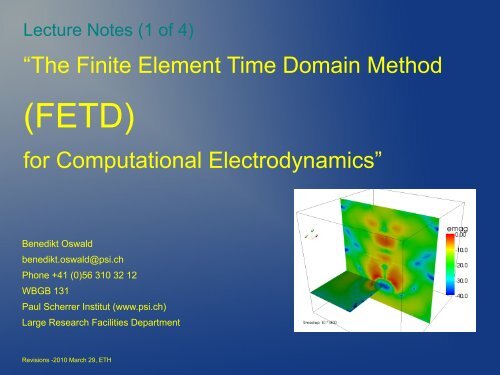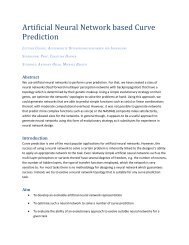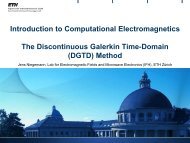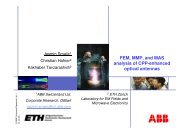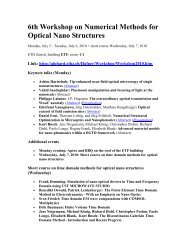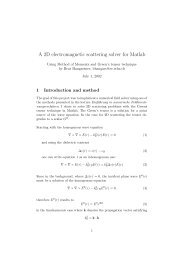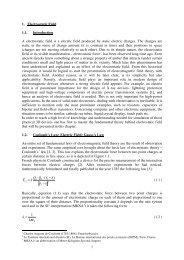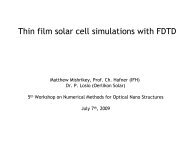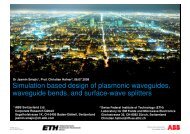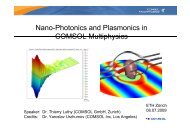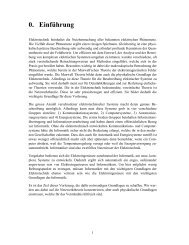t - Computational Optics Group
t - Computational Optics Group
t - Computational Optics Group
Create successful ePaper yourself
Turn your PDF publications into a flip-book with our unique Google optimized e-Paper software.
Lecture Notes (1 of 4)<br />
“The Finite Element Time Domain Method<br />
(FETD)<br />
for <strong>Computational</strong> Electrodynamics”<br />
Benedikt Oswald<br />
benedikt.oswald@psi.ch<br />
Phone +41 (0)56 310 32 12<br />
WBGB 131<br />
Paul Scherrer Institut (www.psi.ch)<br />
Large Research Facilities Department<br />
Revisions -2010 March 29, ETH
Passion is required for any great work,<br />
and for the revolution passion and<br />
audacity are required in big doses<br />
Ernesto 'Che' Guevara, Letter to his parents.
Acknowledgements<br />
It is my pleasure to acknowledge various contributions to this lecture:<br />
in alphabetic order<br />
Adelmann, Andreas – PSI group leader<br />
Burri, René – world renowned Swiss (Magnum Photos) photographer<br />
Fomins, Aleksejs – summer student contributing to hades3d<br />
Garvey, Terrence – head of ABK<br />
Hafner, Christian – for inviting me<br />
Leidenberger, Patrick – collaborator and esteemed colleague
Literature References<br />
Jin, Jianming; “The Finite Element Method in Electromagnetics”; 2 nd edition, John Wiley & Sons; 2002. ISBN 0-<br />
471-43818-9. Note: reference work<br />
Volakis, John L., and Chatterjee, Arindam, and Kempel, Leo C.; “Finite Element Method for Electromagnetics –<br />
Antennas, Microwave Circuits, and Scattering Applications”; Wiley Interscience & IEEE Press; 1998. ISBN 0-7803-<br />
3425-6. Note: reference work<br />
Novotny, Lukas and Hecht, Bert; “Principles of Nano-<strong>Optics</strong>”; Cambridge University Press; 2006. ISBN 13-978-<br />
0-521-83224-3. Note: motivates applications<br />
Taflove, Allen and Hagness, Susan, C.; “<strong>Computational</strong> Electrodynamics – The Finite Difference Time Domain<br />
Method”, 3 rd edition; Artech House; 2005; ISBN 1-58053-832-0. Note: general inspiration for time domain methods<br />
Zienkiewicz, O. C. and Taylor, R. L.; “The Finite Element Method – Volume 1: The Basics”; 5 th edition;<br />
Butterworth-Heinemann; 2000; ISBN 0 7506 5049 4. Note: fundamentals on finite element methods by its<br />
pioneers in engineering sciences.<br />
And my sincerest apology for all forgotten references, it was not by intention!
Overview<br />
Introduction, Motivation and Governing Equation<br />
Finite Element Method as a Volume Approach<br />
Practical Realization of the Algorithms<br />
Case Studies and Modeling Accuracy
Introduction, Motivation and Governing Equations (1)<br />
Maxwell's equations Constitutive relations<br />
∇× H =j ∂ D<br />
∂ t<br />
∂ B<br />
∇×E=−<br />
∂t<br />
∇⋅D= el<br />
∇⋅B=0<br />
D=⊗E<br />
D=⋅E<br />
j=⋅E<br />
B= 0 ⋅H<br />
Dispersive, scalar<br />
Non-dispersive, scalar<br />
Ohm's law<br />
James Clerk Maxwell<br />
Source wikivisual
Introduction, Motivation and Governing Equations (2)<br />
E lectric field vector wave equation<br />
aka. curl-curl equation:<br />
general dielectric dispersive formulation<br />
∇× 1<br />
<br />
∇×E ∂<br />
∂ t<br />
E<br />
∂2<br />
∂<br />
∗E =− 2<br />
∂t ∂ t J 0<br />
S ubject to boundary conditions and constitutive relations<br />
E=E x , t x ∈ℝ with and 3
Introduction, Motivation and Governing Equations (3)<br />
Why solve Maxwell's equations in the time domain ?<br />
Model transient processes<br />
Model non-linear processes: Raman scattering in near-field optics<br />
Model processes over large bandwidths in one single run<br />
Fields of applications ?<br />
Nano-optics, scanning near-field optical microscope probes, optical antennas<br />
Devices based on plasmonic resonances<br />
Laser assisted field emission for advanced photo-cathodes in accelerators (SwissFEL)<br />
Also, traditional microwave electromagnetics
Introduction, Motivation and Governing Equations (4)<br />
Dispersive Dielectric Material – Debye Model<br />
used for:<br />
alcohols<br />
Water<br />
water in soils<br />
∞<br />
= s − ∞<br />
<br />
t= ∞ t <br />
<br />
<br />
= ∞<br />
1 j <br />
relative permittivity at infnite frequency (often 1.0)<br />
change in relative permittivity due to pole<br />
pole relaxation time<br />
e− t<br />
⋅U t<br />
Source: wikipedia<br />
Peter Joseph<br />
William<br />
Debye;Dutch<br />
physicist and<br />
physical chemist;<br />
1884-1966.<br />
Debye model in time domain<br />
U t = unit step function
Introduction, Motivation and Governing Equations (5)<br />
Dispersive Dielectric Material – Drude Model Source: wikipedia<br />
used for:<br />
Plasmas<br />
Metals in the visible region<br />
p<br />
<br />
2<br />
p = − ∞<br />
2 − j <br />
∞ relative permittivity at infnite frequency (often 1.0)<br />
t= ∞ t 2<br />
p<br />
p<br />
pole angular frequency<br />
angular relaxation frequency<br />
Paul Karl Ludwig<br />
Drude; German<br />
Physicist; 1863-<br />
1906.<br />
1−e − p t ⋅U t Drude model in time domain
Introduction, Motivation and Governing Equations (6)<br />
Dispersive Dielectric Material – Lorentz Model<br />
used for:<br />
Solid in the visible<br />
Metals in the visible<br />
∞<br />
= s − ∞<br />
p<br />
p<br />
= ∞ <br />
pole angular frequency<br />
t= ∞ t 2<br />
p<br />
2<br />
p 2<br />
2 j p p − 2<br />
relative permittivity at infnite frequency (often 1.0)<br />
change in relative permittivity due to pole<br />
damping coeffcient associated with pole<br />
p<br />
2 − p<br />
Source: wikipedia<br />
Hendrik Antoon<br />
Lorentz; Dutch<br />
Physicist; 1853-<br />
1928.<br />
2 ⋅e− p t 2 2<br />
⋅sin p−<br />
pt<br />
⋅U t <br />
Lorentz model in time domain
Introduction, Motivation and Governing Equations (7)<br />
Dispersive Dielectric Material – Drude-Lorentz Model – especially for metals in the visible<br />
= ∞ −<br />
2<br />
p 2 − j <br />
Vial et al., Physical Review B, Vol 71, pp. 085416, 2006:<br />
Gold dielectric data modeled by Drude & Drude-Lorentz<br />
2<br />
p<br />
2<br />
2 j − p<br />
p 2<br />
source ditto
Introduction, Motivation and Governing Equations (8)<br />
Why finite elements ? Rationale ? Concept ?<br />
In order to numerically solve<br />
ordinary differential equations (ODE)<br />
partial differential questions (PDE)<br />
Integral equations (IE)<br />
defined on multi-dimensional, geometrically complicated domains, we<br />
subdivide the complicated domain into elements of simple shape<br />
approximate the solution via functions of know shape but unknown coefficients, aka. Degrees of freedom<br />
formulate systems of equations to calculate the DoF
Introduction, Motivation and Governing Equation (9)<br />
Appeal of the finite element method – level of detail (LoD)<br />
The figure represents an S EM comparison of<br />
the emitter shape from a double-oxidation<br />
mould with the emitter shape from a single<br />
oxidation mould. Fig a) is a 45 degree image of<br />
the emitter from the double oxidation mould,<br />
showing the rounded joins between pyramid<br />
faces. Fig. b) shows the blunted tip of this<br />
emitter from above. Fig c) and d) are the<br />
equivalent views for the emitter from the single<br />
oxidation mould, which has a very sharp tip<br />
(not more than 5 nm - this is about the limit of<br />
the S E M resolution for looking at tips) and it<br />
also has undesirable, sharp ridges where the<br />
pyramid faces meet.<br />
From: Fabrication of all-metal field<br />
emitter arrays with controlled apex sizes<br />
by molding, E. Kirk, S. Tsujino, T. Vogel,<br />
K. Jefimovs, J. Gobrecht and A. Wrulich.<br />
Journal of Vacuum Science and<br />
Technology B, 27(4), 2009.<br />
c)<br />
a)<br />
200 nm<br />
20 nm<br />
1μm 20 nm<br />
b)
Introduction, Motivation and Governing Equation (10)<br />
mesh – element types
Introduction, Motivation and Governing Equations (11)<br />
Ultra-short History of the Finite Element Method in Electromagnetics<br />
...admittedly somewhat arbitrary...<br />
Zoltan Cendes Boris Galerkin<br />
1870 - Rayleigh variational methods<br />
1909 - Ritz ditto<br />
1915 - Galerkin weighted residuals<br />
1943 - Courant piecewise continuous trial functions<br />
1947 - Prager-Synge ditto<br />
1964 - Zienkiewicz ditto<br />
Source CNN<br />
1967 - Zienkiewicz et al. solution of three-dimensional field problems<br />
1970 - Silvester et al. non-linear magnetic field analysis<br />
1980ies - many authors electrodynamics problems, problems with spurious modes<br />
1990ies - Cendes, Webb, edge element to avoid spurious modes<br />
Lee, Nédelec et al. finite element time domain methods<br />
Source wikipedia<br />
Source times<br />
Olek Zienkiewicz<br />
2000nds many authors PML, ABC, boundary integrals, dispersive media in time domain
el anejo dieléctrico (1)<br />
0<br />
0<br />
derivation of the Drude operator L<br />
we need to evaluate: 0<br />
2<br />
p p<br />
2<br />
p p<br />
∂ 2<br />
∂ t 2 u t⊗E = 0<br />
2<br />
p p<br />
2<br />
p p<br />
∂ 2<br />
∂ t 2 −e− p t u t⊗E =− 0<br />
∂ 2<br />
∂ t 2 1−e− p t u t ⊗E<br />
∂<br />
∂ t t ⊗E = 0<br />
− 0<br />
we use: e − p t t⊗E=∫ −∞<br />
thus<br />
0<br />
2<br />
p p<br />
∞<br />
2<br />
p<br />
p<br />
2<br />
p<br />
p<br />
∂<br />
∂ t<br />
2<br />
p<br />
p<br />
∂ E<br />
∂ t<br />
[ ∂<br />
∂ t e− p t ut ⊗E ]<br />
1 st part<br />
2 nd part<br />
∂<br />
∂t [− p e− p t u te − p t t ⊗E]<br />
e − pt ' t ' E t−t ' dt '=E t<br />
∂ 2<br />
∂ t 2 −e− p t 2 ∂<br />
u t⊗E =0 p<br />
∂ t e− p t ut ⊗E −0 2<br />
p<br />
p<br />
∂ E<br />
∂ t
el anejo dieléctrico (2)<br />
we combine the 1 st and 2 nd part<br />
0<br />
0<br />
2<br />
p p<br />
2<br />
p p<br />
∂ 2<br />
∂ t 2 1−e− p t 2 ∂<br />
u t ⊗E= 0 p<br />
∂t e− p t u t⊗E<br />
∂ 2<br />
∂ t 2 1−e− p t 2<br />
u t ⊗E= 0 p[−<br />
p e − p t u te −p t t]⊗E<br />
using the identity from the preceeding slide again, eventually we obtain<br />
0<br />
2<br />
p p<br />
thus<br />
∂ 2<br />
∂ t 2 1−e− p t 2<br />
u t ⊗E= 0 p[<br />
E− p e − p t u t⊗E ]<br />
L Drude = 0<br />
2<br />
p<br />
p<br />
∂ 2<br />
∂t 2 1−e− p t 2<br />
u t⊗E =0 p[<br />
E− p e − p t u t ⊗ E ]
End of 1 st Part<br />
The revolution is not an apple that falls when it is ripe. You have to make it fall (Che)


